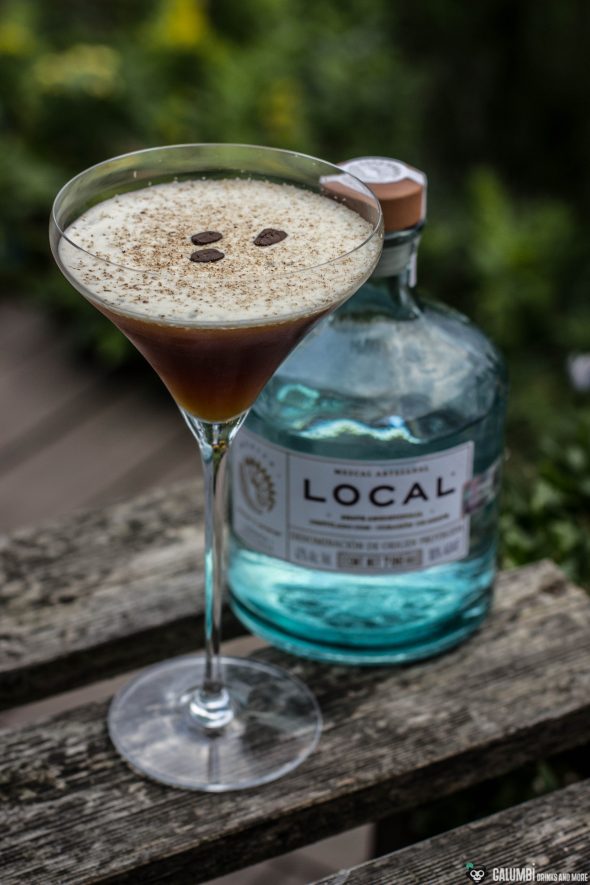
So, once again it is time for Mezcal! Well, and that makes me especially happy in the case of today’s bottle, because we are dealing with a special one about which I have already heard lots of good things. To what extent this premature praise is actually true and whether I can join in the hymn after the tasting remains to be seen, of course. However, on paper, at least some things are already really cool. (provided test product)*
The Mezcal Local is a Mezcal from the Mexican state of Oaxaca, so nothing unusual at first. To be more precise, it comes from San Pablo Villa de Mitla Oaxaca, as you can see on the back of the informatively designed label, and is made there to a 100% from the agave species Espadin (which is also called “Agave angustifolia” here). The agaves for this mezcal grow for a whole 10 years before they are finally harvested and processed – so far, so good. Finally, they are cooked in earth ovens fired with pine wood and then ground in the traditional way with a stone grinder (tahona) operated by a donkey. Finally, the Master Mezcalero Leonel Hernández distils the mash twice on a copper pot still after a ten-day fermentation in open wooden barrels.

Up to this point, it sounds unquestionably very good, but also not quite so unusual. Now the fact that we are dealing with a Pechuga Mezcal is added. In fact, Pechuga actually means as much as turkey breast and is probably a term that is familiar to many people from the menu of a Mexican restaurant. For Pechuga mezcals, turkey breasts or other pieces of meat are actually added to the still (usually hung in) to achieve a special taste. If this sounds too scary or weird, I can reassure you: for the Mezcal Local no turkey had to lose its life and no other meat was used here. In the Mezcal context, the term Pechuga also describes the piñas, the agave hearts. And such an agave heart was added during the distillation process. But that’s not all, a fruit basket with oranges, bananas, apples and peaches was also hung in the distillery, so that the rising steam passes through the fruit (a similar procedure is perhaps known by many from the production of some gins).

Finally, with an abv of 42% the Mezcal finds its way into a very nice, heavy and bulbous bottle. This special Mezcal costs about 60 Euros, which is a reasonable price considering the handmade production and the details mentioned above.
But now to the all-important question: What does it taste like? And is it worth the purchase?
Tasting notes:
Aroma: Wow, this is really something special here in my glass! Yes, it is recognizably a Mezcal with its typical notes of smoke and that earthy, mineral note that I always find in agave distillates and which I appreciate very much. But then there are indeed fruity notes. The German spirits blogger Helmut Barro describes them as reminiscent of a Obstler in his blog schlimmerdurst.net (German language only), which I can actually understand. I can’t isolate the fruits mentioned above in the description of the production process, but I find some diffuse exotic and very nicely integrated note. Rough notes of tobacco and leather come through with time and bring spicy impressions.
Taste: On the palate, the very interesting characteristics that are already present in the aroma continue. Here I have, besides spicy and smoky notes that are by no means too dominant, an aromatic agave with vegetal notes, mineral salt and white pepper. In addition greenish earthy tones of unripe bananas, oranges (yes, on the palate I can isolate them), again leather and tobacco as well as sublime herbal notes. This is a really beautiful, complex and expressive Mezcal, which does not earn this predicate by brute force, but by a very successful balance of multi-layered and partly unconventional facets.
Finish: long-lasting agave tones with mineral salt, a hint of white pepper and some mint.
The smoke, the slightly fruity character, the expressive overall character and in addition a certain tiredness on my part were the main reasons for the cocktail I mixed with this Mezcal. I very seldom drink vodka-based drinks, but an espresso martini can be an occasional drink. Inspired by the original, Aztec cocoa, the Xocólatl (which means “bitter water” in the Aztec Nahuatl language and is made from cocoa, cinnamon and chili and sometimes other spices and herbs), I wanted to create a variation of Dick Bradsell’s classic that would knock me out aromatically. So this wasn’t just about waking up a British model at the counter, this was more divine: “Wake me up, and then sacrifice me to Quetzalcoatl!


Recipe “Wake me up, and then sacrifice me to Quetzalcoatl!”:
4.5 cl Mezcal Local
4 cl high-quality espresso
1 cl cinnamon syrup
0.5 cl agave syrup
2 bar spoons Dark Crème de Cacao
3 Dashes Dr. Sours #9 3 Chiles Bitters
Preparation: Shake all ingredients vigorously on ice and strain into a pre-cooled glass.
Glass: Martini
Garnish: grated nutmeg and three coffee beans

Buying sources: At specialized retailers or online
*The fact that this product has been sent to me free of charge for editorial purposes does not – in any way – imply any influence on the content of this article or my rating. On the contrary, it is always an indispensable condition for me to be able to review without any external influence.

Pingback: Siglo Cero Pox and the Pox Negroni - Galumbi